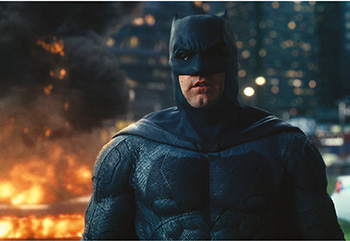SUPERHERO TECH
FROM SCI-FI TO SCIENCE
Ruwandi Perera reveres the superheroes who have inspired techy innovations
San Diego Comic-Con is coming up later this month and is perhaps one of the largest pop culture events in the US; it is where fans dress up as their favourite fictional characters to celebrate superheroes.
In addition to saving the world, superheroes have always been very technologically advanced – what with their cutting-edge suits, weapons and basically everything that they use to get the job done (sorry, Hulk!). Fans tend to revere individuals such as Marvel Comics legend Stan Lee, DC Entertainment’s Geoff Johns and Star Trek creator Gene Roddenberry for being ahead of their time.
And they continue to be awed and inspired by their creations.
Everybody’s favourite Gotham City protector Bat-man is the perfect example of technology overtaking superpowers. With his utility belt, Batarang, Batmobile and Batwing, wealthy playboy Bruce Wayne somehow has an innovative gadget for every sticky situation he flies into.
His chemistry savvy archenemy – the Joker – is also a regular human with a penchant for goofy pranks using lethal concoctions and thematic weapons including his favourite Joker Venom, which is literally a deadly laughing gas.
Less dark, more innovative and slightly more expensive, Tony Stark’s Iron Man suit is one of Marvel’s many…. well, marvels.
Iron Man’s seemingly humble Mark I suit has evolved into an astounding Mark XLII. Armed with grenades, lasers, hand repulsion and jet boot propelled flight, the suit can be controlled telepathically by Stark and works in any situation on land, at sea or in space. Experts say the detachable multifaceted Iron Man suit can actually be made today – we’re just short of an arc reactor.
Telepathic communication is explored in many superhero stories including Guardians of the Galaxy. Star-Lord Peter Quill (who wears a suit that enables him to travel through space) also has a psychic connection with a sentient energy form called Ship, which can take any shape and is technically a weapon. That and his Element Gun, which can project air, earth, fire and water, makes Quill a technologically gifted interplanetary outlaw.
Talking about technology in comics, there’s no denying the mecca of it all: Wakanda. This fictional African nation is abundant in ‘vibranium’ – the strongest and most powerful metal in the universe, according to Marvel.
Headed by T’Challa a.k.a. Black Panther, this country has some of the most technologically advanced infrastructure such as ‘Kimoyo beads’ and the high-speed magnetic levitation rail system, which reportedly inspired Tesla’s Elon Musk and his Hyperloop linking Washington D.C. to New York City.
While many of us gawk at these techy superheroes and fictional characters, others find inspiration in them and try their best to emulate their lifestyles – minus the end of the world stuff, of course.
For instance, the father of the cellular phone Martin Cooper got his inspiration from Star Trek: The Original Series. Captain Kirk’s communicator and the handheld devices used by all crew members got Martin thinking at Motorola.
Following him, geniuses such as cofounder of id Software John Carmack (who replicated the fictional plot device ‘holodeck’ through 3G game engines) gained immense inspiration from the beloved television series. Although we’re yet to witness a handheld universal translator along the lines of what Captain Kirk uses while warp speeding across the galaxy, we are inarguably almost there today – sorry, there’s no ready translation for Klingon just yet.
Video calls were also ubiquitous in science fiction with movies such as 2001: A Space Odyssey, Blade Runner and Back to the Future Part II showcasing characters looking at each other during calls. The first video call in film was probably when Alfred Abel, starring as Joh Fredersen, made a call to a subordinate in the German expressionist sci-fi drama film Metropolis back in 1927.
In Star Wars: Episode IV – A New Hope, remember when Princess Leia’s image is projected by R2-D2? This is perhaps one of the first illustrations of holographs.
While the princess pleaded with Obi-Wan Kenobi for help, nowadays scientists are trying to create 3D projections for a range of requirements such as guiding surgeons during delicate operations. When it comes to holograms for entertainment, we are already there. Remember Michael Jackson at the 2014 Billboard Music Awards?
Perhaps superheroes and science fiction teach us that technology plays as much of a role as superpowers do. It’s not who you are underneath but what you do that defines you, isn’t it?




